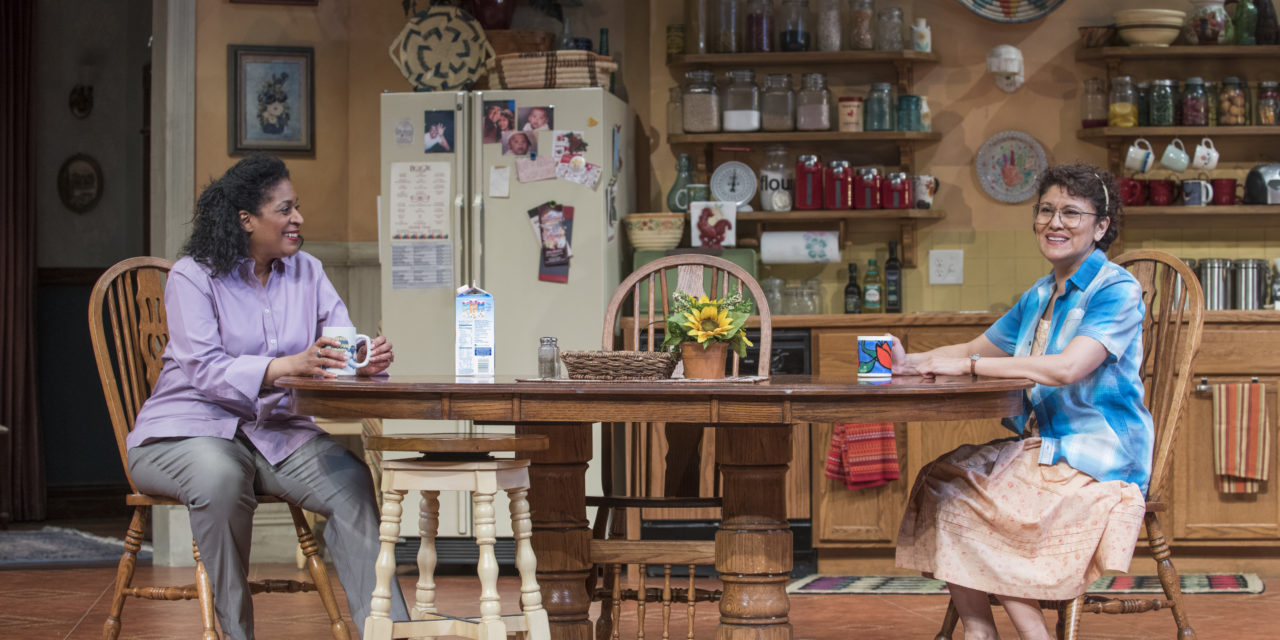Everyone has a bad roommate story. Whether it was your college roommate or your little sister growing up. We’ve all been there. Everyone. Hard stop. This all too familiar concept is precisely where Steppenwolf Theatre Company’s production of Jen Silverman’s The Roommate grounds itself. And while most bad roommate situations don’t get better, there are some that do.
Enter Sharon and Robyn, the play’s two protagonists. Sharon is from Iowa. She’s nice. But her new roommate Robyn, newly arrived from the Bronx, thinks she is nosy and far too talkative. While the duo may be a recipe for disaster, ultimately Silverman’s play uses the comical mismatch formula to present a surprising and touching story of friendship that speaks to how our decisions early in life can eventually lead to challenges later in life. As newly minted roommates, Sharon and Robyn must come together through their differences to find common ground. Even if their friendship is short-lived, both women will continue influencing each other for the rest of their lives. The Roommate stars ensemble members Ora Jones as Robyn and Sandra Marquez as Sharon who have an infectious chemistry with each other. The energy between them and the bond they form during their time together is palpable
Under the direction of Tony Award winner Phylicia Rashad, the Chicago premiere of The Roommate runs through August 5, 2018. The play received its world premiere at the Actor’s Theatre of Louisville in 2015 and has since been produced at South Coast Rep, Williamstown Theatre Festival, and SF Playhouse.

Ensemble member Sandra Marquez (Sharon) in Steppenwolf’s Chicago premiere production of The Roommate by Jen Silverman. Photo by Michael Brosilow.
In a nutshell, the two-hander celebrates female friendships and mid-life renaissance. Recently divorced, Sharon is looking to start over. Her first step is to find a roommate to help her pay the bills for her home in Iowa. Robyn is looking for a place to hide and start over. Where better to do this than Iowa? Commonly called The Odd Couple meets Breaking Bad, the play slowly cranks up the heat as both characters struggle to find meaning in their lives. Robyn wants to forget about her former life and past mistakes. Yet, the same things that Robyn is trying to put behind her as precisely the things that add excitement to Sharon’s boring life. In the end, how far will each woman go to change? Is there a limit?
Moreover, the play represents a welcome addition to the canon by creating two meaty roles for women in their 50s, something severely lacking in the American Theatre. As Silverman notes in an interview with Diep Tran for American Theatre,
“As women, once you’re out of your 30s, in this particular society in America, you become slightly invisible.”
In her welcome notes in the program, Steppenwolf Artistic Director Anna D. Shapiro recalls the “Invisible Women Syndrome” to describe the way that women between the ages of 45 and 60 are rendered invisible. Put simply, they aren’t represented. Silverman adds:
I had been thinking for a while of how, when I go to the theatre, I rarely see any roles for women of that age range that are not supporting roles. When I do see older women onstage, or women in their 50s or 60s onstage, those women are generally just there; the play’s actually about younger people but those women are there to, you know, have a couple of jokes or have a couple of jokes made about them.
So I really wanted to write a play for badass women in their 50s. I sort of thought that, like, there is a kind of energy, a kind of concentration that happens when they are the two players on that stage and they have all that agency and all that power.
Silverman directly addresses this gap, hopefully providing a spark for the resurgence of dynamite roles for middle-aged women.

Ensemble member Ora Jones (Robyn) in Steppenwolf’s Chicago premiere production of The Roommate by Jen Silverman. Photo by Michael Brosilow.
While watching The Roommate, I kept thinking about how I couldn’t recall seeing a two-hander with just two middle-aged women on stage. That both women were people of color only added to the pressing need for this play. Here was a production featuring a Black woman (Jones) and a Latina (Marquez) dealing with things that everyone goes through. Aside from a few bits and pieces here and there—Samantha C. Jones’ costumes for Marquez and Rob Milburn and Michael Bodeen’s sound design come to mind—neither actress was forced to represent their ethnic and racial identities. This was never a topic of conversation and it shouldn’t have to be. We, as audience members and theatre-makers, should reach a point where actors of color are given the chance to play three-dimensional roles even if the character is not written with ethnic or racial markers in mind. We must look beyond the white normative body. One thing is for sure, in between the laughs and poignant moments, Steppenwolf’s The Roommate delivers 90 minutes of what theatre can and should look like.
This post was written by the author in their personal capacity.The opinions expressed in this article are the author’s own and do not reflect the view of The Theatre Times, their staff or collaborators.
This post was written by Trevor Boffone.
The views expressed here belong to the author and do not necessarily reflect our views and opinions.


















